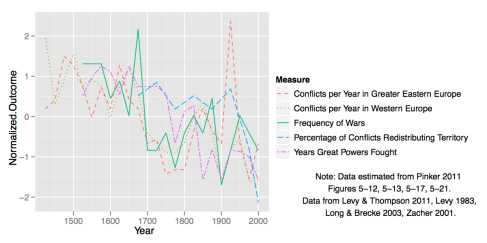Making predictions about social trends of any kind is extremely difficult and arguably impossible. Past efforts at prediction have been notoriously unsuccessful, as Dan Gardner has shown compellingly in his recent book Future Babble. In my opinion we just do not understand war and international relations well enough to predict anything twenty years into the future.
Certainly if the trends of recent decades continue, the coming decades will be more peaceful. But that’s an “if.” There’s no guarantee that recent trends will continue. Nonetheless, by recognizing recent trends away from war we can craft policies based on past successes, such as increasing support for the United Nations.
I’d like to address one common fear about war in the coming decades – the rise of China relative to the United States. Political scientist and leading “realist” John Mearsheimer (2010: 382) has written that “to put it bluntly: China cannot rise peacefully.” My view, by contrast, is that a great-power war involving China is possible alright, but not inevitable and actually not even that likely.
Must a rising China inevitably come to blows with the United States as the former hegemonic power in decline? The analogy is to the rise of Germany and the challenge it posed to Britain before the World Wars. But China, unlike 19th-century Germany, follows a “peaceful rise” strategy and has not fought a single military battle in 25 years (the only permanent UN Security Council member in that category). Also Germany felt denied its due status in the international system, as it came late to the colonial game and had few overseas possessions. But China has its due status as a permanent veto-wielding member of the UNSC, thanks to the foresight of Franklin D. Roosevelt in the creation of the UN, back when China’s power was anything but great.
China’s leaders stay in power by delivering economic prosperity based on international trade. A future war against the United States or another great power would wreck the pursuit of this trade-based wealth. That would be irrational on the part of China’s leadership, which has so far proven both peaceful and generally rather cautious in world affairs. Given that a great-power war in the nuclear age would be absolutely catastrophic for the participants, one would have to assume a level of craziness or stupidity from China’s leaders that completely departs from their behavior in recent decades. They may be exasperating as negotiating partners, or brutal as human-rights abusers, but they are not crazy.
The most dangerous possibility of war would involve an accidental or unintended escalation of a U.S.-Chinese conflict over Taiwan. The American position is deliberately ambiguous about whether the United States would come to Taiwan’s defense in the event China attacked to re-integrate the island by force. The United States has for decades officially recognized that Taiwan is part of “one China,” and does not recognize Taiwan as an independent country. At the same time, however, the United States sells arms to Taiwan and implies that it might use military means to prevent forceful re-integration. Fortunately, China-Taiwan trade and communication have been increasingly rapidly, and the chances of a declaration of independence, or some other reason for a Chinese attack, are decreasing.
As for the South China Sea, the conflicts there are worrisome but so far have tended to produce calibrated ballets of diplomatic and military maneuvering rather than conquest by force. The stakes in oil and minerals undersea in that area may be lucrative, but they in no way would outweigh the enormous costs of international wars in the region.
Mistakes could happen, trends could shift, things could go badly. But it would be wrong to think of negative outcomes as inevitable, or unstoppable. All evidence suggests that sound policy choices have good prospects to steer U.S.-Chinese relations, as well as those among other great powers, away from war in the coming years.
***
Joshua S. Goldstein is professor emeritus of international relations at American University and research scholar at University of Massachusetts, Amherst. His book Winning the War on War: The Decline of Armed Conflict Worldwide (2011) documents the reduction in the number, size and scope of the world’s wars in recent decades.

